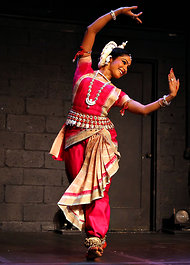 Her guru, Kelucharan Mohapatra, a central figure in the 20th-century revival of Odissi, had intended to make a dance drama from the Ramayana, the ancient epic, for seven characters. But other dancers missed rehearsals. For Ms. Mohapatra, the guru’s daughter-in-law, this was not an option. Filling in for her truant associates gave her the idea to attempt the entire drama, all seven characters, alone. Her guru, Kelucharan Mohapatra, a central figure in the 20th-century revival of Odissi, had intended to make a dance drama from the Ramayana, the ancient epic, for seven characters. But other dancers missed rehearsals. For Ms. Mohapatra, the guru’s daughter-in-law, this was not an option. Filling in for her truant associates gave her the idea to attempt the entire drama, all seven characters, alone.
It’s not unusual in Indian dance for a soloist to assume multiple roles. Two or three are challenge enough, both for the dancer and for a viewer minimally versed in the Ramayana story trying to follow along. (For me there’s always a moment of anxiety before such a dance, as I strive to memorize the synopsis in the program.) Embodying seven characters must be some kind of record. I got a little lost near the end, but I was amazed at how much of the complicated narrative and shifting roles Ms. Mohapatra made clear, even without costume changes.
The details were marvelous. When, as the god Rama, Ms. Mohapatra drew her imaginary bow, you could feel the tension between her extended thumb and pinky stretch across her chest and then through her thighs as she pressed from one bent-kneed position into another. When her Sita, Rama’s wife, cajoled Rama to chase after a golden deer, her pout was irresistible. Her villain, Ravana, was recognizable even while he impersonated a mendicant.
Ms. Mohapatra’s favorite roles, she said, were the animals, and these were breathtaking. Her beneficent vulture seemed to hover. And her golden deer, batting its eyelashes and flicking out a leg midleap, was so charming that you had to remind yourself that it was a demon in disguise.
In Ms. Mohapatra’s pure-dance pieces, many similar virtues were evident. Compared to the Odissi style of the Nrityagram Dance Ensemble, which performed in New York last month, her style was gentler, less pressurized, her manner less modern. Her bare feet slapped the floor strongly, yet her glory lay in her wrists and fingers.
Her wrists and fingers worked in counterpoint to her footwork, pulsing complementarily as she moved. Sometimes they snapped into place at the last moment, putting an exclamation point on a serpentine pose. As her arms arched over her head, Ms. Mohapatra drew attention to the difference between a keystone of clasped hands and one of a hand gripping just a finger.
The only flaw in Ms. Mohapatra’s presentation was the music, which was not only recorded but also partially marred by some awful synthesizer sounds.
She was not the only dancer on the program, which took place at the Club at LaMaMa in the East Village. Prashant Shah, a Kathak expert trained in Ahmedabad, in Gujarat state, but based in New York, had the daunting task of following her. His performance suffered by comparison. And because Kathak depends more on a back-and-forth with musicians, his dancing, though rhythmically precise, was harmed by the taped accompaniment.
In lieu of musicians to interact with, Mr. Shah enlisted the audience in a call and response. It was, he said, his way of erasing borders. Nice try.
The Erasing Borders Festival of Indian dance continues through Sunday; (212) 594-3685, iaac.us.
|

